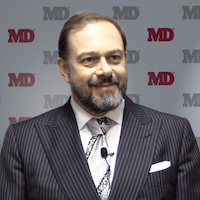Article
Gilenya Outperforms Copaxone, Reducing Multiple Sclerosis Relapses
Author(s):
In a head-to-head trial, fingolimod (Gilenya) significantly reduced relapses over the course of one year compared to glatiramer acetate (Copaxone), in patients with relapsing-remitting multiple sclerosis.

Bruce Cree, MD, PhD
Results from the phase 3b ASSESS study comparing fingolimod (Gilenya) to glatiramer acetate (Copaxone) in patients with relapsing remitting multiple sclerosis show that fingolimod significantly reduced the annualized relapse rate compared to glatiramer acetate.
Patients treated with fingolimod .5 mg had a 40.7% relative reduction in the rate of relapses over a period of one year, compared to glatiramer acetate (annualized relapse rate [ARR] estimates .153 vs .258, respectively P = .0138).
"ASSESS is the first controlled head-to-head study of a MS disease modifying therapy versus Copaxone to show superior efficacy in reducing relapses, a key measure of disease activity and a significant burden for patients," said Bruce Cree, MD, PhD, MAS, George A. Zimmermann Endowed Professor in Multiple Sclerosis at the University of California San Francisco, and ASSESS Principal Study Investigator in a statement. "Head-to-head trials, such as ASSESS, are extremely important to help clinicians better understand the relative efficacy and safety of MS therapies, thereby making better-informed treatment decisions."
Participants in the rater-blinded and dose-blinded study (n = 1064) were randomized to receive either once-daily oral fingolimod .5 mg (n = 352) or .25 mg (n = 370), or once-daily injections of glatiramer acetate 20 mg (n = 342). Novartis began the ASSESS study in patients with relapsing-remitting multiple sclerosis in 2012 as part of a post-approval agreement with the US Food and Drug Administration.
While the risk reduction was significant among patients receiving fingolimod .5 mg, patients receiving .25 mg doses did not have statistically significant reductions in the annualized relapse rate compared to placebo.
Fingolimod is approved by the FDA for the treatment of relapsing forms of multiple sclerosis for patients ≥10 years of age. The .5 mg dose is approved for patients ≥10 years of age weighing >40 kg, while the .25 mg dose is approved only for pediatric patients weighing ≤40 kg.
The Gilenya Prescribing Information lists common adverse reactions (occurring in ≥10% of participants and more often than placebo) as headache, liver transaminase elevation, diarrhea, cough, influenza, sinusitis, back pain, abdominal pain, and pain in extremity.
"Gilenya reimagined MS care as the first oral treatment and is a testament to Novartis' quest to stop MS," said Danny Bar-Zohar, MD, Global Head of Neuroscience Development, Novartis Pharmaceuticals. "The ASSESS data add to the robust body of evidence which show that Gilenya is a highly efficacious, cornerstone therapy in relapsing MS."




